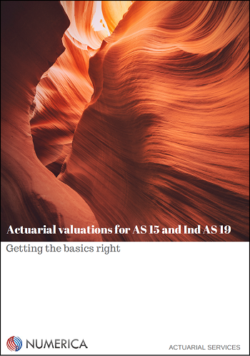
There is more to selection of discount rate than simply looking up the interest rates on internet. Many companies don’t realise the complexities involved and need to do more than they are doing currently.
Any actuarial valuation involves the use of a ‘discount rate’, which is used to calculate the present value of future benefits promised by an employee benefit scheme.
This post only covers the selection of discount rate. Details on other topics related to actuarial valuation of employee benefits can be found here.
Whose responsibility is it?
What is prescribed under the accounting standards?
Most accounting standards prescribe that the discount rate should be set equal to the yield to maturity on Government bonds (Government securities, or GSecs) having term consistent with the term of liabilities, as at the date of valuation.
The reference made to ‘term’ is important. The yields on bonds vary with their term and when yields are plotted against their respective terms, the resulting chart is called the ‘yield curve’. An example of a yield curve is shown below.
The accounting standards prescribe that the discount rate selected should be read from the yield curve that existed on the date of valuation.
The ‘term’ referred to in the accounting standards is generally agreed to be the ‘duration’ and the yield curve should be a ‘Zero Coupon Yield Curve’ or ZCYC, derived from the yields on GSecs.
Can online sources be used for setting the discount rate for actuarial valuation?
Many websites provide estimates of discount rates. For example, Bloomberg displays Government bond yield of many countries, including India and can be seen here. Using online sources has advantages and disadvantages. The most obvious advantage is that these are easily accessible. The disadvantages are:
- They are only available for select durations and do not show the full yield curve. This makes online sources of limited use if the duration of liability is long. In particular, it is generally not advised to rely on internet sources for assessing discount rates for pension or post-retirement medical benefit schemes because duration of these benefit schemes could far exceed the duration of any GSec being traded in the market.
- Some of these websites use generic algorithms across various countries so may not allow adequately for the distortions that exist in the Indian market
For these reasons, it is usually the best to use online sources to cross-check the discount rate chosen by your actuary, rather than to directly relying on them. That said, the online sources may be used if the employee benefit liabilities are not material. The company, rather than their actuary, should make that call.
The yield curves produced by the Clearing Corporation of India Ltd (CCIL) circumvent both drawbacks encountered with other online sources. Their yield curves have been in use across the Indian financial services industry for more than a decade. At Numerica, we rely on them to deliver actuarial services.
We have published the yield curves produced by CCIL on our website and can be found here. This also includes a tool to check the correct discount rate to be used for AS 15 or Ind AS 19 actuarial valuations.
Refer to our quarterly discount rate reports to understand the movement of discount rates over each quarter and the impact that could have on your employee benefits liabilities.
What companies must do
Companies should always request a full explanation to be provided in the actuary’s valuation report, including an explanation of the financial data, and the methodology the actuary has used in setting this assumption. Methods include Smith-Wilson, Nelson-Siegel, cubic splines, but a simpler method can be used on grounds of materiality. Whatever method is used, it is important that an explanation is provided.
Even when an actuary has used an external or an online source to set the discount rate, the actuary should explain the methodology that was used in the construction of the corresponding yield curve and why the actuary thinks that the discount rate chosen meets the requirements of the accounting standard.


December 07, 2017 at 12:09 am, How to set salary escalation assumption for actuarial valuation - Numerica said:
[…] of our posts highlighting the issues involved in setting the discount rate can be found here and another one setting out considerations for the employee attrition rate can be accessed here. […]
December 14, 2017 at 2:20 pm, FAQs about discount rate for actuarial valuation - Numerica said:
[…] Setting the discount rate for actuarial valuation correctly is often not very well understood by the reporting companies. This post summarizes some of the most common questions our clients and their auditors ask about choosing the right discount rate. For a complete overview about setting the discount rate, please refer to this post. […]
December 21, 2017 at 10:21 am, 7 issues to consider for auditing actuarial valuation reports • Numerica said:
[…] corporate bonds). And understand that the discount rate varies by the duration of DBO. We have a separate post describing methodology. Another post sets out FAQs around discount […]
December 28, 2017 at 4:50 pm, Impact of increase in gratuity limit on actuarial liability • Numerica said:
[…] our previous posts, we have explained how to set discount rate, salary escalation rate and attrition rate assumptions for actuarial […]
March 07, 2018 at 10:16 am, Actuarial valuation of gratuity - understanding the sensitivities said:
[…] in the actuarial valuation. Setting the right discount rate can be a complex task (read more here) and the process should be given due […]